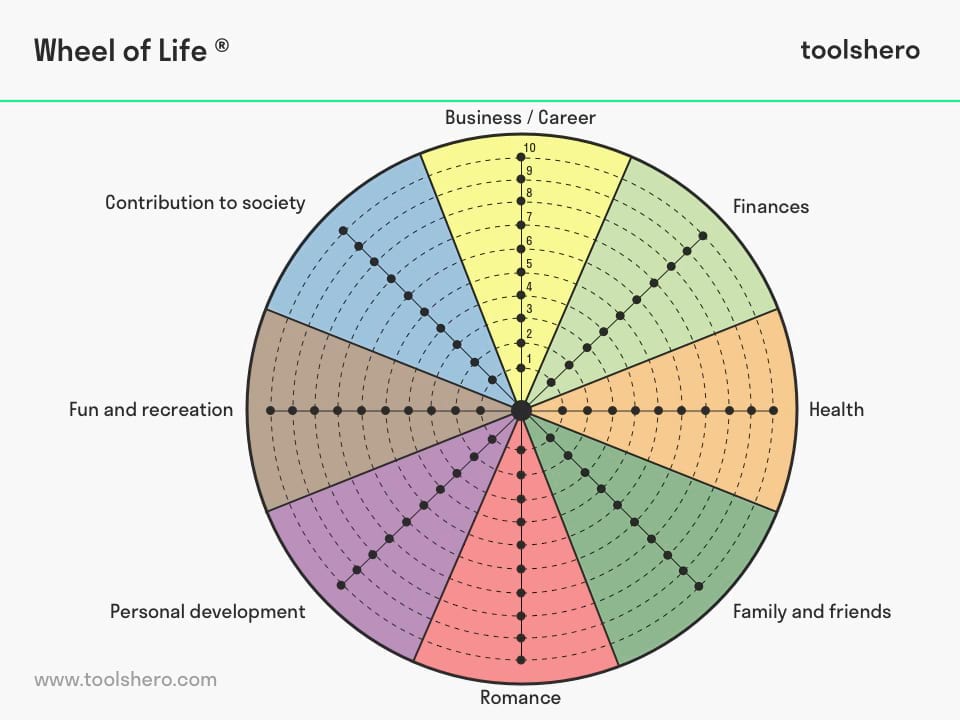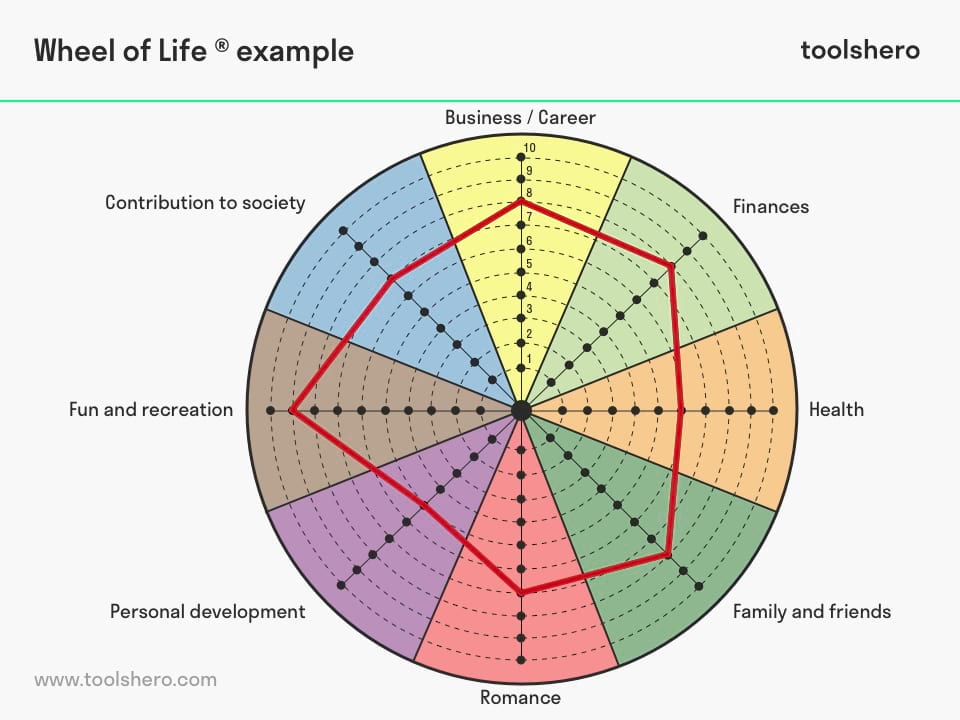Wheel of Life Assessment and Template

Wheel of Life Assessment: this article will provide a practical explanation of the Wheel of Life Assessment. After reading this, you will understand the basics of this personal happiness concept which brings balance to your life. This article also contains a downloadable and editable template, which you can print as handout. Highlights of this article: what is the Wheel of Life, how does it work, what are the steps and how to make your own assessment. Enjoy reading!
What is the Wheel of Life?
The Wheel of Life® shows how to bring balance to your life and create happiness and success. It originates from Tibetan Buddhism and focuses on eight components, which are also called happiness factors in human life.
However, this method should not be confused with the Tibetan version, which focuses more on the awareness of the personal state of mind.
The concept of the wheel of life was then further developed by Paul J. Meyer, who founded the Success Motivation Institute® in 1960.
Wheel of Life meaning
The method, also called balance wheel or coaching wheel, is often used as a goal setting method and coaching method.
The Wheel of Life® is intended to help identify how an individual spends his time and how satisfied this person is about the different parts and areas that life has to offer. This creates a type of self-reflection, that allows you to get (even) more out of life.

Figure 1 – Wheel of Life® (Meyer, 1960).
Subdivisions wiothin the wheel of Life
The Wheel of Life® consists of a pie chart, which represent different important areas of your life.
The most common subdivisions are:
- Business & career
- Finance
- Health
- Family & friends
- Romance
- Personal development
- Fun & recreation
- Contribution to society
Additionally, it is always possible to add or leave out categories or to, for example, split the category of family & friends into two.
The Wheel of Life
A Course Exercise for a More Balanced and Happier Life
How does the Wheel of Life work?
In order for the wheel of life assessment to be of value to you, you need to fill the template and each category correctly.
Every slice of the pie represents a category. Each of these slices can be assigned a value of 1 (very bad) to 10 (very good).
The value of 1 is closest to the centre of the circle and the value 10 is at the edge of the circle. After filling it in, a kind of spider web is created and it is possible to see at a glance what categories score less and what the life satisfaction of that moment is.
Every part influences one’s individual life. By completing the wheel in all honesty and correcting it if needed, you find out what is going right and which parts may need more attention. The more extreme the number, the more improvement that category could use.
When filling in the Wheel of Life, it does not matter with which category you start.
Steps to create a Wheel of Life
To obtain a helpful wheel of life assessment, it is useful to follow the steps below:
Step 1. Start
Create a template; a circle containing the 8 slices representing the different categories. Make a subdivision of 1 (close to the centre) to 10 (outside of circle) to fill in the scores. Of course, there are also The Wheel of Life® templates available online.
Step 2. Fill in
Filling in the scores provides an overview of the individual’s sense of contentment in the various categories. It is important to take your time for this, and not to fill in the scores too quickly or allow yourself to get distracted.
Reflecting on each category requires concentration and only by filling it in seriously, you can get an accurate view of your balance in life and the way in which you react to setbacks. Of course, there are several considerations per category, but below you will find the most obvious descriptions:
1. Business & career
How satisfied are you with your job, is it the job that you had imagined or would you rather pursue another career? Does the job bring you happiness and satisfaction? Does the job earn enough for a living? Etc.
2. Finance
Are all incomes enough to meet all basic needs and other needs? Are you not dependent on loans? Do you have any debts? Is money the only thing that makes a person happy? Etc.
3. Health
How physically and mentally healthy are you? How do you feel? Are you satisfied with your appearance and weight? Do you have any physical discomforts? To what extent are you engaged in sports? Etc.
4. Family & friends
Are friends supportive, unconditional and trustworthy? Can friendships be built upon and friends always be counted on? To what extent do you spend your free time with family and friends? Consider friends and family in the Wheel of Life assessment.
5. Romance
Have you found happiness in love? Do you have a new partner or a committed partner who you can rely on? Etc.
6. Personal development
How do you deal with personal growth? Are you open to new experiences and eager to learn? Are you spiritually connected to both the inner and outer world? Etc.
7. Fun & recreation
Are you enjoying life? Do you practice hobbies or sports? How do you spend your free time? Etc.
8. Contribution
Do you help others? Do you volunteer? To what extent are you active at (sports) clubs, in the neighbourhood or taking care of family members?
Step 3. Reflection
After filling in all of the scores, The Wheel of Life is completed. The spider web now shows any surprises, peaks and drops or regularity.
With scores from 8 to 10 you are very satisfied in a specific category. It is important to ensure that this is maintained, and remember that improvement in this area is always possible.
With scores from 5 to 7, you are reasonably satisfied with a category, but there is definitely a chance for improvement and to achieve goals.
Scores from 1 to 4 show that someone is not happy at all about this particular area. You have to find ways to improve the satisfaction here.
Nevertheless, such scores provide plenty of opportunities. Often, people forget that there are always opportunities to improve an aspect of life.
The following questions can be useful:
- Why did you give yourself such a low score on this category?
- What is the ideal score for each category?
- What score do you want to achieve after a month, after 3 months, after 6 months and after a year?
- Which categories score less?
- Which categories are of individual importance to be able to achieve balance?
The completed Wheel of Life assessment is an individual starting point and can be grim or balanced in appearance. It says something about how efficient and effective someone is in life. Of course, it is easy to be extremely satisfied with one category, but what else should happen to the other categories?
For example, if you spend all the time and energy on your career, that will undoubtedly also have a positive effect on the finances. But to what extent are you then satisfied with relationships with friends and family? What is the result of this for health, well-being and relaxation?
By looking at all aspects and ensuring that they are all connected, balance can be found in life. The key is to find balance in life, which the wheel of life may assist with.
The wheel of life assessment allows people to see what situation they are currently living in. It also forces them to think ahead and challenge limits, which makes the wheel expand and grow.
Step 4. Action
Following the earlier steps, the Wheel of Life can be put into motion. The visual image of the filled in wheel can directly indicate where the necessary steps need to be taken. Now you can ask yourself which specific actions are needed to improve a category. Incorporate these required actions into an action plan.

Figure 2 – Wheel of Life® example of assessment results
By looking at the filled in visual representation of the Wheel of Life® on a daily basis, it becomes easier to really work on improvements.
This way it is possible to track your progress. Generally, it takes half a year to a year to succeed in bringing categories to an acceptable level of satisfaction, so there is a need for perseverance.
Wheel of Life assessment and template
Start to identify how an individual spends his time and how satisfied this person is about the different parts and areas that life has to offer with this ready to use assessment template.
Download the Wheel of Life assessment
This template is exclusively for our paying Toolshero members. Click here to see if a membership is something for you!Now it’s your turn
What do you think? Have you already filled in your wheel? Has this article given you an idea on how to get started? Let your own Wheel of Life inspire you to further develop yourself in life.
Share your experience and knowledge in the comments box below.
More information
- Byrne, U. (2005). Wheel of life: Effective steps for stress management. Business information review, 22(2), 123-130.
- Mahathera , V. N. (2017). Buddha and his Teachings. Pariyatti Publishing.
- Sopa, G. L. (1984). The Tibetan “Wheel of Life”: Iconography and doxography. Journal of the International Association of Buddhist Studies, 7(1), 125-146.
How to cite this article:
Mulder, P. (2017). Wheel of Life Assessment. Retrieved [insert date] from Toolshero: https://www.toolshero.com/psychology/wheel-of-life/
Original publication date: 12/23/2017 | Last update: 12/17/2023
Add a link to this page on your website:
<a href=”https://www.toolshero.com/psychology/wheel-of-life/”>Toolshero: Wheel of Life Assessment</a>













5 responses to “Wheel of Life Assessment and Template”
Hi Patty, Excellent article. I really enjoyed it! I am however interested in the outcome. Did you receive a lot of feedback in the form of individually completed wheels? I really would like to know, if the data was compiled over a significant test group, what the average person, male or female, circle would look like? Hope that I am making sense? do you know of any studies revealing this? just to see where the average human would be at. Thank you, Joe
Hi, Thanks for your great article. Actually, I think All these means is that instead of hiding from failure, insanely successful people anticipate and integrate failure into their lives in ways that transform it from an end into a means. We all love a good secret. But the truth is, when it comes to success, there’s no such thing. So start small, but start today. Wish you all the best.
Thanks for this awesome article its motivate also for the best life ahead.
A Tremendous article I just enjoy it and find out many aspects of life to do work on it.
Is it possible to share with me the typical questions to be asked in each category of wheel of life , in order the users get the correct or right score?